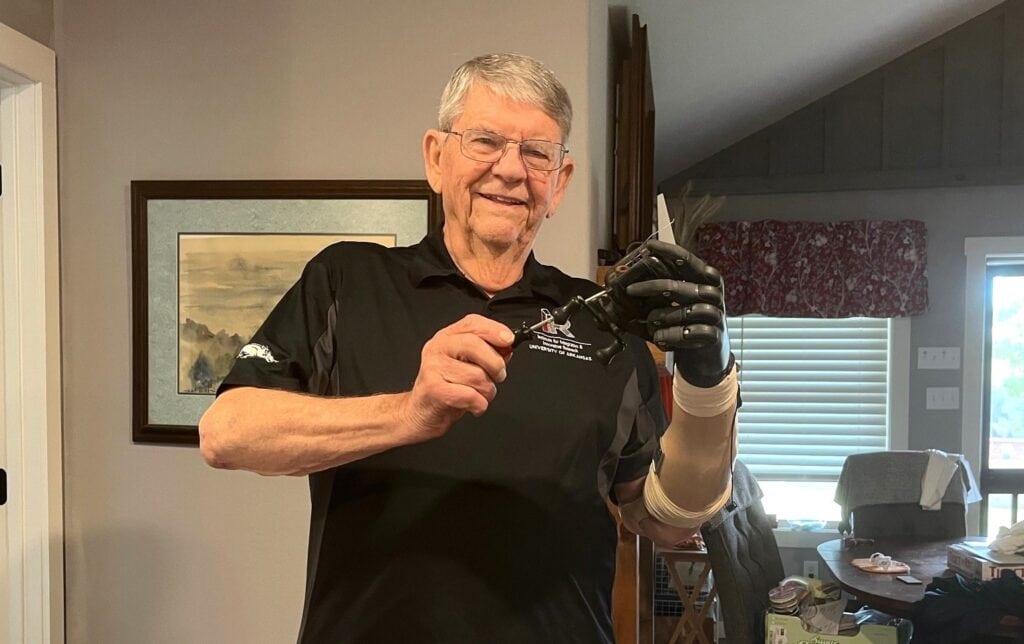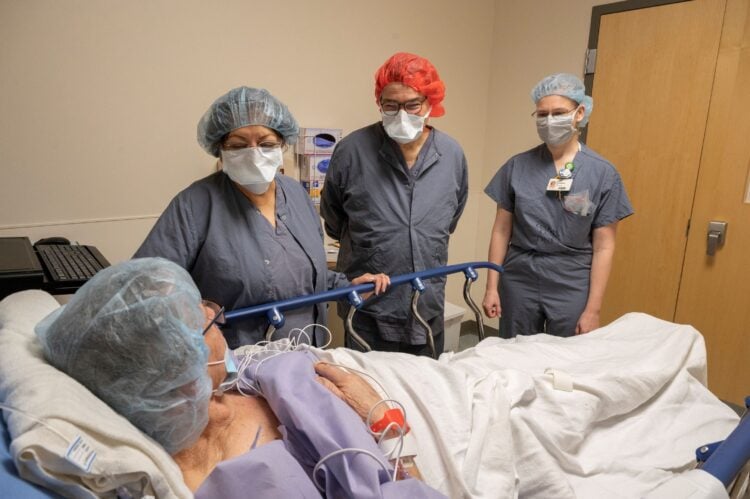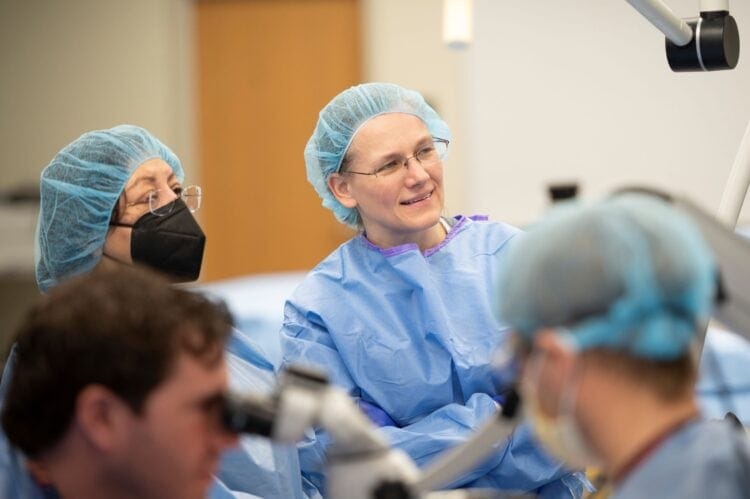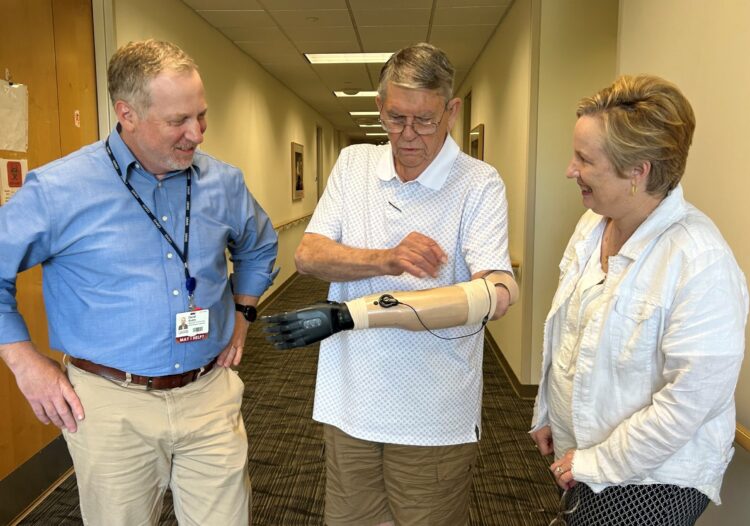As Dewey Hickey took apart and reassembled a bait casting reel using an experimental prosthetic hand system, he marveled at the revolutionary technology that made it possible.

“It amazes me,” said Hickey, who in January 2023 became the first Arkansan and only the second person in the world to receive the device, which restored his sense of touch and grip force. “This has even enhanced the science fiction buff in me.”
A retired pastor, Hickey, 85, said he was skeptical when he first heard about the innovative device, which is part of a research collaboration between the system’s inventors at the Institute for Integrative and Innovative Research (I³R) at the University of Arkansas at Fayetteville and the University of Arkansas for Medical Sciences (UAMS).
“I told them upfront I didn’t think it was going to work on me because I haven’t had use of my hand for 75 years,” said Hickey, whose amputation stemmed from a bicycle accident when he was 10.
Before agreeing to receive the experimental prosthesis, he met with the I³R inventors and then the UAMS surgery team, led by neurosurgeon Erika Petersen, M.D.
In his first meeting with the I³R team, James Abbas, Ph.D., who co-leads the team, gripped his left arm above the amputation and asked Hickey to move his nonexistent thumb. He hesitated, telling Abbas that it seemed impossible, but Abbas encouraged him to try his right thumb first, then to think about having a left thumb. Hickey focused on the muscles that would have moved the thumb, then did the same to make a fist.
“I feel it,” he recalled Abbas telling him. “You’ve got everything we need to work with.”

Abbas, who has a joint appointment with UAMS in the College of Medicine Department of Neurosurgery, led the discussions that brought the team of UAMS surgeons, Snell Prosthetics and Orthotics and health technology companies together with I³R’s Adaptive Neural Systems Group (ANS). The UAMS Translational Research Institute also facilitated collaboration on the study.
Next, Hickey met with Petersen, director of the Section of Functional and Restorative Neurosurgery in the College of Medicine Department of Neurosurgery who has a courtesy appointment with I³R, and UAMS orthopaedic hand and nerve specialists John Bracey, M.D., and Mark Tait, M.D., both in the Department of Orthopaedic Surgery.
“Dr. Petersen is who I primarily spoke with, and she is very personable,” he said. “I met with them for over an hour, and finally Dr. Petersen turned to Dr. Abbas and said, ‘Look, I know this man’s about to be 84 years old, but his body is not, and his mind is certainly not.’”
The December meeting concluded with Hickey agreeing to the Jan. 9, 2023, surgery, with hopes that his participation will someday help soldiers and others who have lost limbs.
“By that time, they had given me a complete understanding of what the program was about, and I said, ‘Yes, I’m willing to do the research — whatever you want me to do,’” he said.
The ongoing clinical trial is titled, “Neural Enabled Prosthesis for Upper Limb Amputees,” and has been approved as an investigational device by the Food and Drug Administration. The project is supported by the U.S. Department of Defense, National Institute of Biomedical Imaging and Bioengineering of the National Institutes of Health, and the UAMS Translational Research Institute.
‘A promise of what’s to come’
The UAMS surgeons used their complementary expertise to implant electrodes and other components that are part of the device, and which enable communication from the prosthetic hand system to the brain through the arm’s median and ulnar nerves.

Bracey and Tait had the delicate task of implanting the thinner-than-human-hair filament wires into Hickey’s nerves.
Petersen, whose expertise is helping expand the use of new and evolving technologies that can alter a patient’s nerve activity, known as neuromodulation, ensured that the neurostimulator portion of the device was placed appropriately in Hickey’s arm.
Petersen’s leadership of clinical trials testing implantable electrical devices since 2015 has produced profound outcomes for patients with intractable pain and movement disorders. She continues to lead studies of potential new procedures for Parkinson’s disease, chronic migraines, stroke and spinal cord injuries.
The prosthesis technology, Petersen said, significantly advances the ability to harness the power of the human nervous system.
“Mr. Hickey’s case is an exciting promise of what’s to come for people with amputations around the globe,” she said.
The neurostimulator in Hickey’s upper arm receives commands from the prosthesis-mounted components and produces electrical pulses that get conveyed to his nervous system, enabling the sense of touch. During his surgery, the I³R team observed and occasionally consulted with the surgeons.
Bracey and Tait work with many individuals with amputated limbs, and they have dreamed about such a breakthrough.
“The idea of enabling someone to feel with their prosthesis is pretty meaningful, and we’re excited to be part of this groundbreaking project with the I³R team,” Tait said.
A Eureka Moment
Only about a week out of surgery, Hickey began working with the I³R team two days a week in Fayetteville. During his three-hour sessions, the team helped him acclimate to the device and fine-tuned its settings as he worked on activating and recognizing the sensations in his long-latent nerves.
About 12 weeks post-surgery, Hickey had a eureka moment as he was watching television with his wife. His prosthesis was off, and he began to recognize the phantom sensations of his missing fingers.
“I was sitting there, and I said, ‘Oh my gosh, that’s my index finger; that’s my middle finger; that’s my ring finger; that’s my little finger.’ I identified my fingers for the first time. They have never been there before, well, since I was 10 years old.”
“Now, when I shake hands with somebody, I really can feel their hand with the prosthesis,” he said.

Throughout the intensive sessions with the I³R team, Hickey said he developed a bond with Abbas, Ranu Jung, Ph.D., who co-leads the program, and others on the team.
“They are just some of the most compassionate people I’ve ever been around,” he said. “You get the sense they really care.”
The clinical trial is open and recruiting participants with amputations below the elbow. Visit ans.uark.edu to learn more. For questions about the study, contact anslab@uark.edu or 479-718-2390.
This research is supported by the U.S. National Institute of Biomedical Imaging and Bioengineering (NIBIB; R01 EB023261) and U.S. Army Joint Warfighter Medical Research Program (W81WXH1910839). Abbas and Jung are the principal investigators.
The Translational Research Institute is supported by a Clinical and Translational Science Award from the NIH National Center for Advancing Translational Sciences (grant UM1 TR004909).
